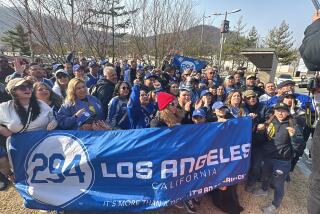Veneer of Calm in the DMZ : Silent Enemies Face Off on Truce Line in Korea
- Share via
PANMUNJOM, Korea — The demilitarized zone separating the two Koreas teems today with deer, pheasants, spectacular Manchurian cranes and wild azaleas--thriving unhindered on nature’s bounty in a no-man’s-land.
But on each side of the DMZ, established at the end of the Korean War in 1953, men at arms stand in a tense face-off.
To the south are Americans and South Koreans. To the north are the North Korean Communists. They were enemies in the war and are silent enemies today, observing the world’s longest-standing truce.
Only the sound of birds comes from inside the 2 1/2-mile-wide zone that stretches 154 miles across the Korean peninsula at the 38th Parallel.
Rusty, Unreadable Signs
The old yellow signs indicating the Military Demarcation Line at the parallel are rusty and mostly unreadable, overgrown by the man-high grass that once sheltered the fabled and extinct Korean tiger, the ancient symbol of the Korean nation.
Lt. Dugald B. Campbell of the U.S. Navy, who escorts visitors to the Panmunjom truce village, said the zone has become an unplanned wildlife preserve.
“No one is allowed to shoot in the DMZ, and the animals know it,” he said. “That’s at least one benefit from the Korean deadlock.”
The wildlife has multiplied during the last 33 years while the Military Armistice Commission of senior officers from both sides has met periodically in a wooden hut on the truce line to discuss complaints from either side. Their liaison officers meet daily on operational details.
The hut has a door at both ends. A green-baize-covered table stands exactly on the truce line. The regular stony-faced dialogue at that table is the only contact on one of the world’s most carefully sealed borders.
The truce line zigzags through lush, rolling hills, paralleled by heavily fortified defense lines on both sides.
The animals keep away from the busy armistice hut. The mile-wide Joint Security Area around the hut is patrolled by troops of both sides, but they don’t step over the line or fraternize. Each side regards the zone as a potential flash point.
The Americans and South Korean troops still fly the United Nations flag, a remnant of the three-year Korean War, although the United States is now the only U.N. member with operational forces in South Korea. North and South Korea have never been admitted to the United Nations.
2 Recent Outbreaks
Campbell said North Korean soldiers sometimes shout insults at the South Koreans across the line or spit at them when they come close. The South Koreans are under orders not to respond.
Twice in recent years, lives have been lost in sudden eruptions of violence in Panmunjom.
Defectors regularly cross in both directions across mine fields laid on each side of the truce zone. Troops on the southern side have discovered three infiltration tunnels that the North Koreans tried to dig under the DMZ. Campbell said defectors have reported 19 other tunnels under construction. But none have been located, he said.
Last April 15, a fire started by North Korean peasants to clear weeds from their nearby rice paddies accidentally swept into the southern sector and blazed out of control for nearly four hours.
The North Korean troops made no effort to help the southern forces fight the flames.
“That was par for the course,” U.S. Army Lt. John Bushyhead said. “We expect no cooperation from them.”
Damage to the southern military observation posts was narrowly averted. But five acres of trees and scrubs burned on both sides of the line, up to a few feet from U.N. Outpost 5.
Across the line, a gleaming North Korean village of four-story houses is visible from Outpost 5. A North Korean flag flies atop a 500-foot steel flagpole. Campbell described it as “the world’s largest flag.”
The village is uninhabited, he said, but is studded with loudspeakers directed toward the U.N. lines. They blare out praise of North Korean Communist leader Kim Il-Sung 24 hours a day.
“We call it propaganda village,” Campbell said.
More to Read
Sign up for Essential California
The most important California stories and recommendations in your inbox every morning.
You may occasionally receive promotional content from the Los Angeles Times.










